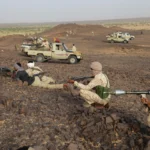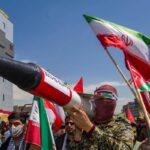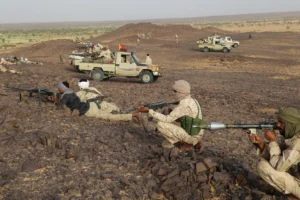With a trickle of aid flowing into the besieged Gaza Strip from Egypt, humanitarian staff and diplomats face a web of political, security and logistical obstacles as they try to build up and sustain deliveries of relief.
The aid is desperately needed. Supplies of food, water, medicines and fuel have been running critically low for Gaza’s 2.3 million people since Israel began its bombardment and “total siege” of the Palestinian enclave in retaliation for a lethal incursion by Hamas militants on Oct. 7.
But Israel’s conditions for inspecting and tracking the aid, security risks transporting and distributing it, and arrangement of its passage through a crossing not used during previous conflicts for large-scale relief efforts have all hampered work to get the operation off the ground.
Aid began flowing through Rafah, the main exit and entry point for Gaza that does not border Israel, on Saturday, with up to 20 trucks crossing daily since. United Nations officials say 100 trucks are required daily to meet essential needs.
During past conflicts between Israel and Hamas in Gaza, aid had mainly been delivered through crossing points with Israel, and the United Nations aid operation for the Palestinian territories has been run through Israel since the 1950s.
Now aid needs to be brought in from Egypt’s Sinai Peninsula, an isolated region with a recent history of insurgent attacks and a heavily militarised border.
“It’s a huge, huge undertaking to set up a humanitarian operation from scratch,” said one aid official who asked not to be named. “We’re not set up like that, not even close, from the Egyptian side.”
The aid operation was brokered in talks involving the United States, Israel and Egypt, with a deal to start with a convoy of 20 trucks clinched during a visit by Joe Biden to Israel last week, aid officials and diplomats say.
As it began, details of an inspection system were still being worked out.
Scaling up aid required a quick and light system based on random checks, such as that used for sending aid from Turkey into northwestern Syria, U.N. aid chief Martin Griffiths said.
Trucks are currently driving more than 40km (25 miles) south along the Egypt-Israel border to be inspected before returning to Gaza, meaning a lag of several hours between their entry into the crossing on the Egyptian side and their exit into Gaza.
“There are bottlenecks,” said Abeer Etefa, a spokesperson for the World Food Programme, which brought some supplies into Gaza with the first convoys but has many more waiting on the Egyptian side of the border.
“What exactly are these bottlenecks? It’s very unclear, but I think a lot of it is basically, probably the inspection mechanism and the ability of movement inside Gaza,” she said.
Some Gaza bakeries the WFP works with have been put out of operation because of shortages of fuel, a commodity that has so far not been allowed to cross because of Israeli concerns that it could be used by Hamas.
Fuel is also crucial for hospital generators and water supplies, and is fast running out.
U.S. Special Envoy David Satterfield, who has been negotiating with Israel, Egypt and the United Nations to set up sustained aid deliveries, told MSNBC on Sunday that while the critical role of fuel was understood, the provision of food, water and medicine would continue to be the focus “in the immediate future”.
Israeli authorities did not immediately respond to a request for comment.
The United States, along with other countries, has also been negotiating to get thousands of foreign passport holders out of Gaza through Rafah, while Qatar has been leading efforts for the release of hostages taken by Hamas militants during their Oct. 7 incursion into Israel.
Two Egyptian security sources linked scaling up of aid to Hamas’s willingness to free hostages. From a total of more than 200 hostages, two were freed through Rafah late on Monday, with Hamas crediting Qatar and Egypt for their mediation. Two others were released last week.
The United Nations says delivery of aid should be unconditional.
On the Gaza side of the border, distribution will depend on the pattern of the conflict and mass displacement of residents, which could be further complicated by an expected Israeli ground operation.
As intense bombardment continues, aid organisations have appealed for a humanitarian pause or ceasefire to deliver relief. Security guarantees, especially for northern Gaza where Israeli bombing is concentrated, had not been forthcoming, said Rick Brennan, emergencies director for the World Health Organization. The U.N. agency for Palestinian refugees says 35 of its staff have been killed in Gaza since Oct. 7.
Bombardment has damaged roads and buildings around Rafah. Not long after Sunday’s convoy of trucks entered the crossing, shelling from an Israeli tank hit an Egyptian position nearby, wounding several Egyptian border guards
Israel said the incident was an accident. “We’re going to have to adapt the whole logistics of the operation according to what is transpiring on the battlefield,” said Griffiths.
Source: Y!News










Add Comment